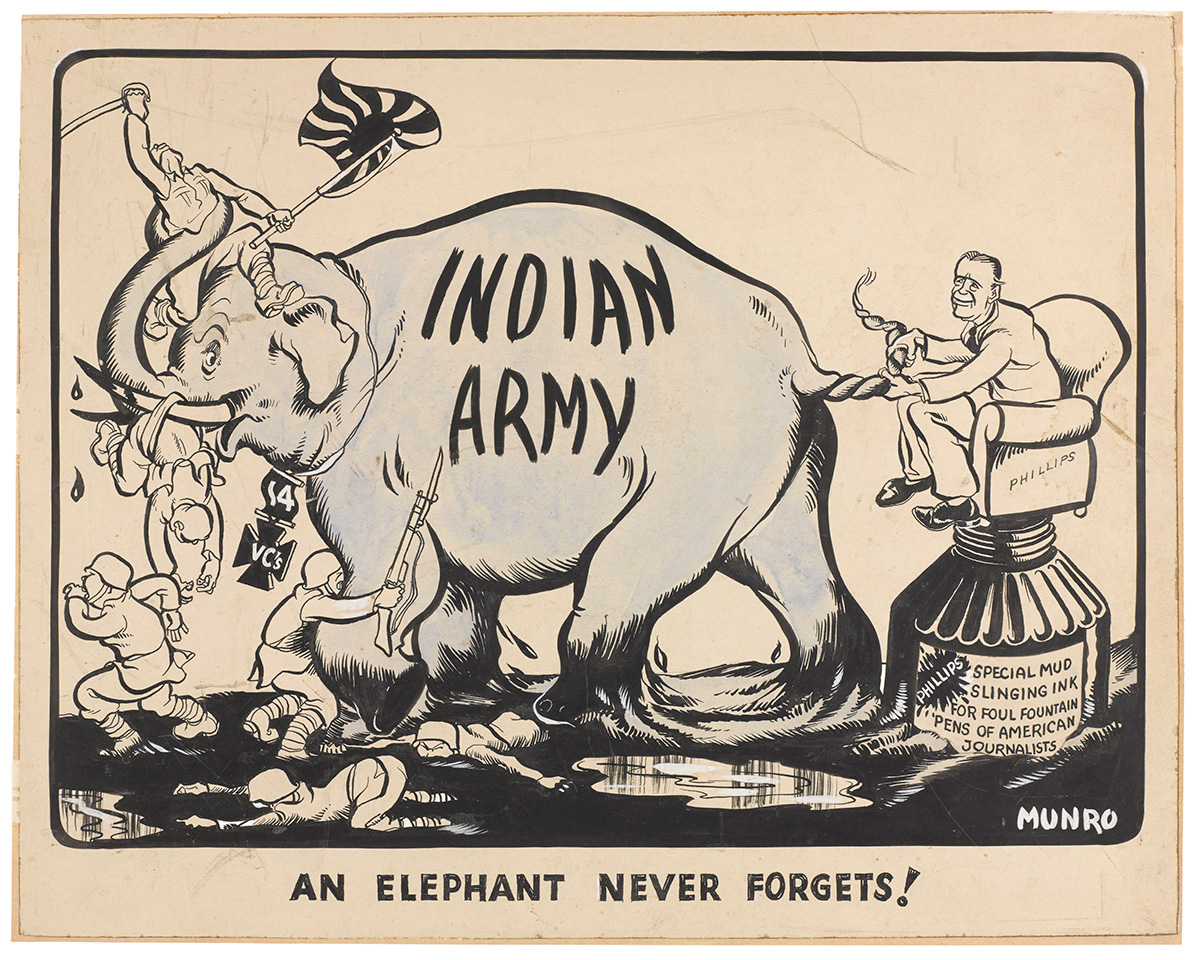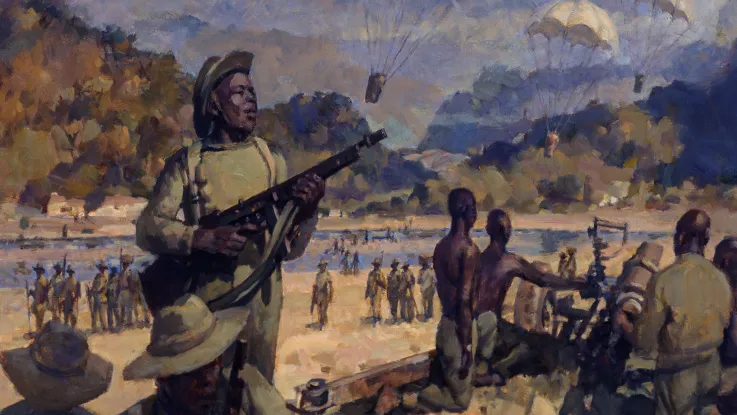Dedicated display ‘Beyond Burma: Forgotten Armies’ to mark 80th anniversary of VJ Day
Thursday, 14 August 2025
Marking 80 years since VJ (Victory over Japan) Day, this special exhibition explores the multinational army that fought in some of the toughest conditions of the Second World War.
- Exhibition dates: Tuesday, 16 September 2025 to Monday, 13 April 2026
- Press preview: Monday, 15 September 2025
Featuring over 180 objects, this will be the first national museum exhibition on the Burma campaign in the 21st century. Through personal objects, diaries, artworks, oral histories, weapons, uniforms and photographs, the exhibition will explore the retreat from Burma in 1942, the transformation and resurgence of the British and Indian forces in India during 1943, as well as the campaign against the Imperial Japanese Army during 1944-1945.
Burma (now Myanmar) became a vital battleground between British India and Imperial Japan. Often overlooked by the contemporary press, it became known to many of those who fought there as a ‘Forgotten War’ fought by the ‘Forgotten Army’.
Known collectively as the Fourteenth Army, the soldiers were a multinational force drawn across Britain, India, Africa and Burma, who were joined by American and Chinese soldiers to resist and ultimately defeat the formidable Imperial Japanese Army. It also reflects on their efforts to keep the peace in the aftermath of victory, and on the campaign’s legacy for the people of India, Burma and beyond.

'An elephant never forgets’, c1943
The exhibition will shine a light on the soldiers’ voices and stories, which remain underrepresented in the narrative of the Second World War, as contemporary news stories focused on events in Europe. A caricature from 1943 captures this struggle. It depicts an elephant of the Indian Army trampling on Japanese soldiers, while an American diplomat, William Phillips, sits behind it and twists its tail.
The exhibition focuses not only on those who served, but the pioneering methods developed by troops to overcome the challenges of unfamiliar jungle terrain, monsoon rains, deadly creatures and tropical disease.
A stand-out object is an abstract painting - ‘And the World was covered in darkness' - by Major Conrad 'Dick' Richardson Romyn, who experienced intense fighting in Burma. This artwork represents the claustrophobic nature of jungle warfare and the evils of war with intense colours of blue and green that capture the dense Burmese jungle environment.
The Army also made major medical advances under these challenging conditions. By the last two years of the conflict, malaria casualties were treated at Malarial Forward Treatment Units. Treated within 24 hours of an attack, patients could return to their unit within weeks rather than months. In the exhibition, two simple objects that survive from the time, a bottle of Army anti-mosquito cream and a vial of anti-malarial tablets, are testament to this work.
The campaign began in defeat, with around 130,000 Allied soldiers taken prisoner after the fall of Singapore in February 1942, who then endured the trauma of captivity long after the Second World War had officially ended. The medal group of Subedar Makhmad Anwar also demonstrates the human sacrifice and horrifying conditions as a prisoner of war.
Human stories of experiences in prisoner-of-war camps are captured by the personal items of Gunner Moss Simon, who was a prisoner of war for three years. A tin identity bracelet and food bowl, which he carved with the Star of David, are in the exhibition. After the war, he kept the bowl on his mantelpiece.
Also on display will be a Military Medal awarded to Corporal Dogo Manga who served with 1st Battalion, the Nigeria Regiment, Royal West African Frontier Force. In the Arakan on 5 March 1945, Corporal Manga’s section was attacked but their machine gun jammed after firing two rounds. He rushed across and fixed it. When he was ordered to withdraw, he was the last to leave carrying a wounded comrade.
More seemingly ordinary objects show the impact of world-altering events on those who served in the global conflict. A visual example is a glass bottle contorted and flattened by the force of the atomic bomb dropped on Hiroshima in 1945.
Alongside stories of endurance and survival, visitors will discover how a diverse mix of soldiers from across the world came together to achieve ultimate victory, with interactive elements, oral histories, film and maps illustrating how the Burma campaign helped shape the modern world.
Exhibition curator, Dr Alan Jeffreys, said:
'This exhibition will bring to life a pivotal period of military history from the Second World War. We are grateful for the oral histories that feature in the exhibition and tell the stories of soldiers and their families in their own words. We are pleased to display and have on loan John Randle’s Victoria Cross, which is only one of two Victoria Crosses awarded during the Battle of Kohima.'
Director of the National Army Museum, Justin Maciejewski, said:
'We’re proud to be marking the anniversary of VJ Day by highlighting the campaign in Burma and those who fought there. We believe that their efforts and achievements should never be forgotten, and seeing their personal objects, artworks and writing up close is a powerful reminder of their extraordinary stories.'
Exhibition narrative
The exhibition tells the story of the campaign through four sections:
- Defeat in the Jungle
- Transformation of the Indian Army
- Victory in the Jungle
- Beyond Burma
Exploring the early catastrophic campaigns in Malaya and Burma, and the harrowing experiences of prisoners of war, Defeat in the Jungle covers a series of heavy defeats in Hong Kong, Malaya, Borneo, and Burma where Indian and Burmese troops suffered huge losses.
Transformation of the Indian Army explores the sweeping changes to command that were made to improve military effectiveness. Under leaders such as General William Slim and General Claude Auchinleck, the Indian Army became a well-trained force that adapted to jungle warfare, which along with medical advances, meant the army could fight the terrain, the climate, the diseases and the Japanese.
Victory in the Jungle highlights the critical role of logistics and air supply in these successes, as well as the Chindit operations. The Chindits numbered 23,000 British, African and Gurkha soldiers trained to survive behind enemy lines. They functioned as a long-range penetration force, disrupting Japanese supply lines and gathering vital intelligence. The Fourteenth Army defeated the Imperial Japanese Army for the first time in the jungle at the Battle of the Admin Box in the Arakan in 1944, followed by the decisive battles for Kohima and Imphal.
After the Japanese surrender in August 1945, large numbers of British and Indian soldiers were deployed to French Indochina (Vietnam), the Dutch East Indies (Indonesia), and across Southeast and East Asia, serving as occupation forces. They faced a range of complex challenges, from repatriating prisoners of war and civilian internees to disarming Japanese troops and conducting counterinsurgency operations against nationalist movements.
Beyond Burma examines how the Burma campaign contributed to the end of British colonial rule in Burma and India. The impact of the Second World War across South and Southeast Asia shaped the region’s geopolitical landscape for decades.
To mark the 80th anniversary of VJ Day and the opening of the exhibition, the National Army Museum will host a Burma Day event: a series of free talks and activities with headliners such as military historian Dr Robert Lyman and exhibition curator Dr Alan Jeffreys, in collaboration with the Burma Star Memorial Fund and the Kohima Educational Trust.
Notes to editors
Images and captions available here:
- Password: Beyond Burma
- https://www.dropbox.com/scl/fo/wdp4du3ei8ss8w4mc1c52/AExBLLx0m0rToBHO49xlVAo?rlkey=vowf8a5pxvwy811v3wtrlr9nz&st=c7ffjnzq&dl=0
For more information on VJ Day, see these National Army Museum stories on the website:
Please contact Sutton PR for interview and image requests:
- Madeleine Mann at Sutton nam@suttoncomms.com
- +44 (0) 7514 097 332
Join in the conversation on:
- X: @NAM_London
- Facebook: facebook.com/NationalArmyMuseum
- Instagram: @nam_london
About the National Army Museum
The National Army Museum shares the history and heritage of our soldiers and their service in the Army, across the globe and down the centuries. Through our collections we explore the history of the Army from its origins to the present day. We aim to engage and inspire everyone with the stories of our soldiers and how their service shapes our world; past, present and future.




